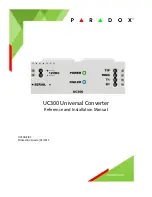
12
300.4 Battery Maintenance and Replacement
This section provides precautions for qualified service personnel working with unit batteries.
Important Safety Precautions
The service technician must take these precautions:
1. Wear protective clothing, eye-wear, rubber gloves and boots. Batteries contain corrosive acids or caustic alkalis and toxic materials
and can rupture or leak if mistreated. Remove rings and metal wristwatches or other metal objects and jewelry. Don’t carry metal
objects in pockets where the objects can fall onto the batteries or into the Inverter system or battery cabinet.
2. Tools must have insulated handles so that they will not short battery terminals. Do not allow a tool to short a battery terminal to
another battery terminal or to the cabinet at any time. Do not lay tools or metal parts on top of the batteries, and do not lay any
objects where they could fall onto the batteries or into the cabinet.
3. Install the batteries as shown on the battery wiring diagram provided in this manual or with the battery cable kit. When connecting
cables, never allow a cable to short across a battery’s terminals, the string of batteries, or to the cabinet.
4. Align the cables on the battery terminals so that the cable lug will not contact any part of the cabinet even if the battery is moved.
Keep the cable away from any sharp metal edges.
5. Install the battery cables so they cannot be pinched by the battery cabinet or the Inverter system cover/doors.
6. Where conductors may be exposed to physical damage, protect conductors in accordance with NEC requirements.
7. If replacing batteries or repairing battery connections, follow the procedure in this manual to shutdown the Inverter
system and remove both AC and DC input power.
8. Full voltage and current are always present at the battery terminals. The batteries used in this system can produce dangerous voltages,
extremely high currents, and possible risk of electric shock. Batteries may cause severe injury if the terminals are shorted together
or to ground (earth). Be extremely careful to avoid electric shock and burns caused by contacting battery terminals or shorting
terminals during battery installation. Do not touch un-insulated battery terminals.
9. A qualified electrician who is familiar with battery systems and required precautions must install and service the batteries. Any battery
used with this unit shall comply with the applicable requirements for batteries in the standard for emergency lighting and power
equipment, UL 924. Cabinets are designed to be used with, and batteries must be replaced by identical cells or a Chloride approved
equivalent. If using substitute batteries not supplied by Chloride, the unit’s UL listing will be void, and the equipment may fail to
perform properly. The installation must conform to national and local codes as well. Keep unauthorized personnel away from batteries.
CAUTION:
A battery can present a risk of electrical shock and high short circuit current. Battery replacement should only be performed
by qualified service personnel familiar with battery systems. All safety precautions outlined at the beginning of this section
must be observed when servicing, maintaining or replacing batteries.
300.5 Routine Battery Inspection and Maintenance Sealed Lead-Calcium Batteries
Lead-Calcium cells are the most common type of battery used today in standby equipment. By design it is as maintenance free as a battery
can be. It is recommended, however, that some simple steps be taken to increase system life and maximize reliability:
• A quarterly visual check of the batteries should be conducted to look for deformities in the cases and terminal corrosion. Any defective
batteries should be replaced. All corroded terminals, regard-less how slight, are to be cleaned and retightened at once to prevent
failure of the entire battery bank.
• Once a year, all battery connections should be checked for tightness and re-tightened if necessary.
300.6 Battery Replacement Procedure
WARNING: Always use the same quantity and type of battery as replacements.
Substituting batteries not supplied by
Philips Emergency Lighting will void the UL listing of the system and may cause equipment failure.
To ensure the superior
performance of your Inverter system and to maintain proper charger operation, replace spent batteries only with Philips Emergency Lighting
cells having the same part number, voltage and ampere-hour rating as the original batteries.
1. Follow the proper shut down procedure as described in Section 300.1.
2. Break down the battery bank beginning with the intercell connectors. These cables tie the batteries installed on the same shelf
together.
3. Next remove the inter-tier cables. These cables connect the batteries located on different shelves together.
4. Remove the batteries from the cabinet. Batteries can be very heavy, use proper lifting methods when removing battery.
5. Install new batteries following the instructions outlined in Section 105.3.
300.7 Battery Disposal
WARNING:
Do not dispose of batteries in a fire, the batteries could explode.Do not open or mutilate batteries. Released electrolyte
is highly toxic and harmful to the skin and eyes.
CAUTION:
Batteries contain lead. Many state and local governments have regulations about used battery disposal. Please dispose of the
batteries
properly.































